Though considerably larger, more effective and reliable than the previous Kynda class, the Kresta I carried half the number of antiship missiles, with just a quarter in reserve. SS-N-12 Sandbox (P-500 Bazalt) protracted development meant they went into service with the obsolete SS-N-3 instead, but it self-defence armament was considerably increased as well C&C and communications facilities. Completed in 1967-69 they served until the fall of the Soviet Union in 1990-95. The class was known by NATO “Kresta I” but it is known in Russia as Proyekt 1134 Berkut (golden eagle) in the navy listing and Admiral Zozulia class cruisers in the general public.
The first versatile Soviet missile cruisers
Development (Proyekt 934)
Project 1134 was in fact the remnant of the large program od large anti-ship rocket cruiser (RKR), stopped when priorities went to ASW warfare. Still armed with large P-35 antiship missiles, they were reduced in numbers and the vessels became “BKP” (large ASW ships). The initial program called for a brigade of seven heavy AsuW ships armed with long range missiles and two brigades of the same number (so 14 in all) of short-range missiles cruisers.
Both were designated as Proyekt 934 and Project 934A respectively. A few command ships (934K) were also planned, but Nikita Khrushchev then in charge rejected these flagship vessels, preferring to stick to the original number, originally to be a lead ship and three pairs of “regular” vessels.
Their proposed main battery was to be replacement for the SS-N-3, the new Ramjet Bazalt (SS-N-12), considered four time as effective at the time. However, their development took time, with many twists and turn, so that when the 934 design was ready, they were still far from being ready for service, leading to a redesign.
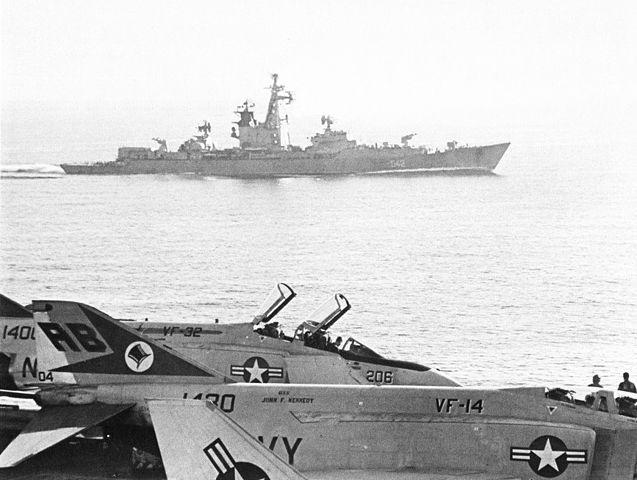
A Kresta I cruiser shadowing USS John F. Kennedy in the Mediterranean sea, 1969
Evolution to Project 1134
Estimations led the admiralty to renounce implementing them and instead choosing a modified and smaller class with older missiles, the P35 Termit (SS-N-3). The program evolved into Project 1134 Berkut, with emphasis on self-defense, with two SAM launchers (instead of one) and ASW helicopters (not on the previous Kynda). With a much larger hull, 6,000 tonnes rather than 4,000, there was enough room to fit also more extensive C&C and communication facilities as well, quintuple torpedo tubes, but smaller 57 mm AA turrets (rather of the now obsolete 75 mm twins on Kynda) and two more RBU ASW launchers. Powerplant wise, this was the same essentially, and both ships had the same speed, but better range. Better even, the Kresta were far less top-heavy, better balanced, and in the end way better seaworthy ships, with good handling characteristics.
Design of the Kresta I
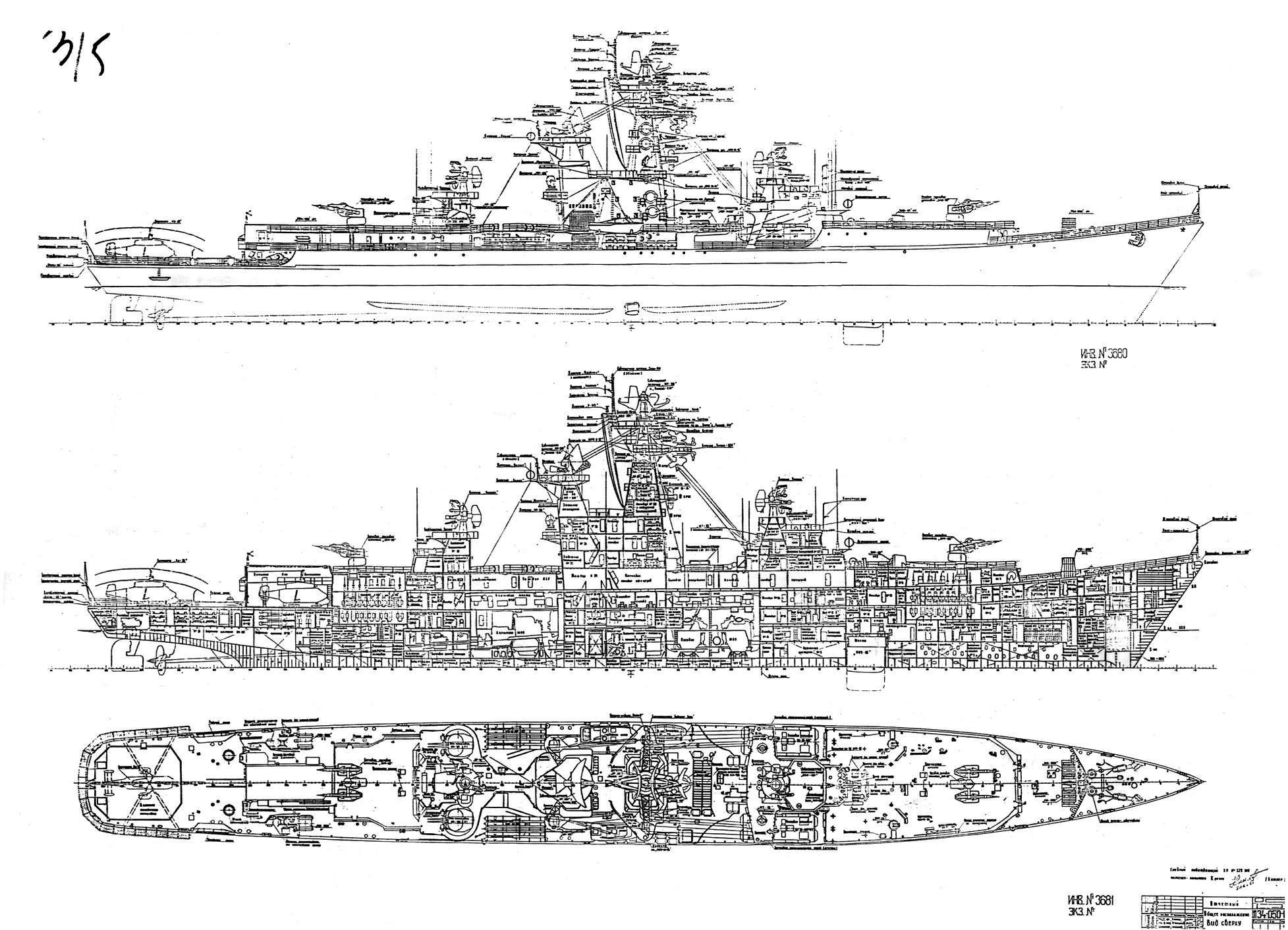
The general design first called an emphasis in size. The displacement was to be 2,000 tonnes heavier so 1/3, than the previous Kynda. Ths meant an overall length of 155 m instead of 141.7 m, and 17 m instead of 15.8 m, and relatively similar draught, 5.5 vs 5.3 m fully loaded. They displaced 6,000 tonnes standard (nominal) versus 4,400 tonnes, and 7,500 tonnes fully loaded (versus 5,600). The hull design was completely different also: The forecastle extended for much of the length, stopping just abaft the hangar doors, with a redesigned poop large enough to accomodate an helicopter spot. On the Kyndas, there was a massive superstructure to reload the missiles fore and aft, while no such system existed on the Kresta.
Project 1134’s two twin launcher tubes were placed on either side of the bridge instead, with its wings above. The superstructure was much elongated, lower, and instead of two masts and two funnels a single “mack” combining a large funnel and electronics above was mated to the mainmast, supporting the largest aerials in a single block amidship.
The superstructures fore and aft were elongated to support the reload systems of both SA-N-1 twin arms missile systems. Their fire control radars were placed on raised platforms for and aft, one over the main bridge forward and one 10 m aft of the mack and mainmast. Both twin 57 mm AA turrets were located abaft the aft SAM control radar. The torpedo tubes were placed on deck, broadsides, in between the aft control radar and mack. The RBU launchers were of two types; the larger (RBU-6000) were placed traditionally at the prow with a wide arc of fire, the smaller (RBU-3000) either side of the hangar aft.
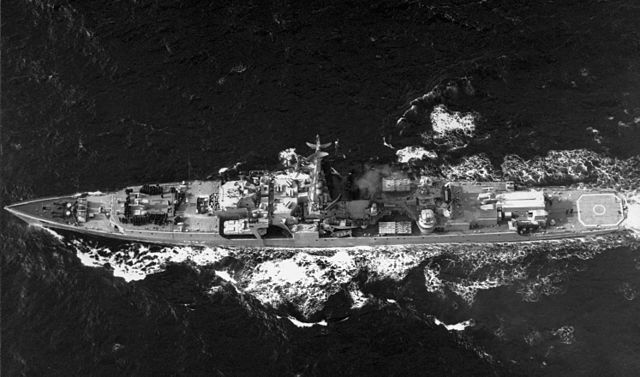
Top view of Vitze admiral Drozd, 1985
Powerplant
The Kresta I and Kynda shared the same powerplant: Two shafts steam turbines and four pressure boilers for a total of 95 to 100,000 shp (68,000–75,000 kW), which allowed for a nominal top speed of 34 knots (63 km/h; 39 mph). The change was the better radius of action, 10,500 nautical miles (19,400 km; 12,100 mi) at 14 knots (26 km/h; 16 mph) rather than only 7,000 nmi at 14.5 knots.
No change was made even during reconstruction o the powerplant in their later years, just maintenance.
Armament
SS-N-3 Shaddock (P-5 “Pyatyorka”)
The Kynda operated a previous generation of the same turbojet-powered cruise missile designed by the Chelomey design bureau. It was first experimented on modified Whiskey class submarines and later equipped the Juliet and Echo class SSGN. The Kresta had just four of these in non-reloading tubes.
Dimensions(C): 11.75 x 0.98m x 5 m
Weight: 5000 kg
Propulsion: Turbojet with launch rocket boosters
Top speed: Mach 0.9
Range: 750 km
Guidance: Inertial guidance, mid-course data link updates, terminal active radar homing.
Warhead: 1000 kg conventional/200-350 kt nuclear
SA-N-1 Goa (M1 Volna)
This ubiquitous system also called S-125 Neva/Pechora was largely exported. It was short-range, weighting 953 kg, 6.09 m long with the booster for a 37,5 cm diameter, 2.2 m winsgpan, and carried a frag-HE 60 kg warhread with proximity fuse. It was propelled by a solid propellant rocket motor and reached 35 kilometres (22 mi); Guidance used the RF CLOS system.
Twin 57 mm AK-725
The 57 mm (2.2 in) were 70 caliber twin turreted guns (denomination AK-725), it was an evolution of the ZIF-31 L/70 57mm (Type 66/76) cannon. The ZIF-31/71/75 mountings were much improved with the AK-725 which became a standard. Mzv: 3,346 fps (1,020 mps), RPM: up to 150. Max Ballistic Range: 9,210 yards (8,420 m)
Quintuple 533 mm TTs
Standard antiship torpedo tubes. Likely the 53-51 non-homing model: Weight 4,134 lbs. (1,875 kg) for 299 in (7.600 m) long, carrying a 661 lbs. (300 kg) warhead at a setting of 4,400 yards (4,000 m)/51 knots or 8,750 yards (8,000 m)/39 knots. It was powered by a Kerosene-air wet heater. It was replaced by the 53-56V from 1966. The latter could reach 14,200 yards (13,000 m) at 40 knots.
On board aviation
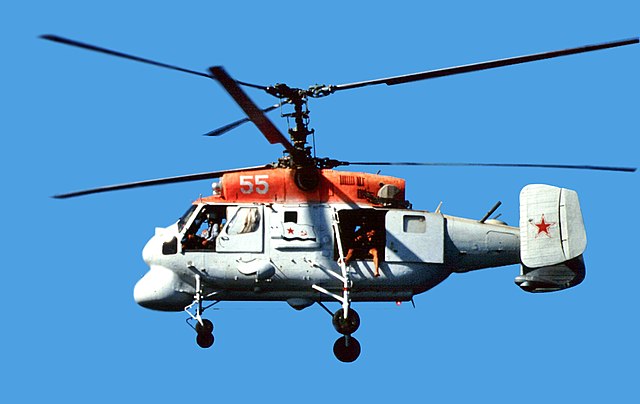
The greatest change was of course the presence of a permanent helicopter. The cramped Kynda was able to host an helicopter in her aft spot, but there was no protection nor facilities for it. On the Kresta class, this was now allowed. A single Ka-25 Hormone B helicopter was carried for three purposes:
-Main: Targeting the cruise missile and mid-course corrections (data link)
-Secondary: ASW patrol and strike
-Tertiary: SAR -Search & Rescue)
Electronics
NATO designations are within brackets.
Radars:
-MR-500 Kliver air search (Big Net)
-MR-302 Rubka (Head net C)
-Two MR-310 Angara (Head Light)
-Two Don-Kay and a Don-2 navigation/SS radar
Sonars:
-MG-312 Titan (Blue Nose)/MG-26
Fire control Radars:
-4R90 Yatagan (Muff Cob) (SA-N-1)
-MR-103 FCS (Bass tilt) (AK-725)
-Binom P35 Progress FCS
Others:
-Khrom-2M IFF (Side Globe)
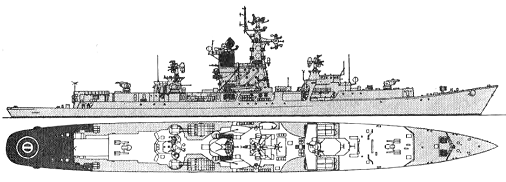
Two views of Amiral Zozulia in 1979

Author’s old rendition of the Kresta I
Specifications Kresta I as completed |
|
| Displacement: | 6,000 tons standard, 7,500 tons full load |
| Dimensions: | 159 x 17 x 6 m (522 x 56 x 20 ft) |
| Crew | 340-360 |
| Propulsion | 4 shafts steam turbines, 4 boilers, 91-100,000 shp |
| Speed | 34 knots (63 km/h; 39 mph) |
| Range | 12,100 nmi at 14 knots |
| Armament | 2×2 SS-N-3, 2×2 SA-N-1, 2×2 57mm, 2×5 533mm TTs |
| Electronics | Radars MR-500, 502, 506, 103, FCR Yatagan, Binom P35, Khrom 2M, Sonar MG-26/312 |
| Aviation | Kamov Ka-25 “Hormone” helicopter |
Further development of the Kresta I class
Proyekt 934:
“armed with eight short range anti ship missiles (SS-N-9) otherwise similar to the ships built. This design evolved into Project 1134A, better known as the Kresta II class (NATO designation).
Project 934K:

Impression of the Project 934K
This was a larger Kresta cruiser (Kommandatur) modified with much more extensive command facilities and larger hangar accepting 4-5 helicopters. It was cancelled.
Project 934K would have received an elongated hull and enlarged helicopter deck aft, larger hangar as well. The five helicopters were to provided data link between the missiles waves launched by the several cruisers it lead.
Career and modifications of the Kresta I
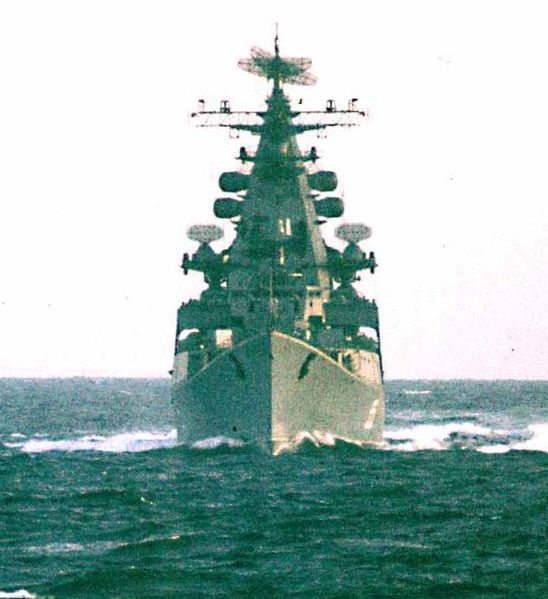
Front view of Murmansk in March 1970
The initial plan was for a single squadron of seven ships armed with long range missiles and two squadrons of fourteen ships armed with shorter range missiles. In reality only four ships were built before production switched to the anti-submarine variant the Kresta II class.
All the crusiers were built at the Zhdanov Shipyard in Leningrad: Admiral Zozulya was launched on 17 October 1965, Vladivostok on 1 August 1966, Vitse-Admiral Drozd on 18 November 1966, Sevastopol on 28 April 1967. They were commissioned in 1966-69, one year apart each.
Modernizations
In the early 1970s they received two twin P-35 SSM (4 4K44) missiles plus two twin launchers for the Progress SSM (4 4M44) missiles.
Later, in the mid-1970s, they received the Don radar (2nd model). In 1974 Admiral Zozulia received a MR-212 Vaygach radar. In 1976, Vitse-admiral Drozd and in 1991 Admiral Zozulia received four extuple 30mm/54 AK-630 CIWS and two MR-123 Vympel-A radars.
Admiral Zozulya
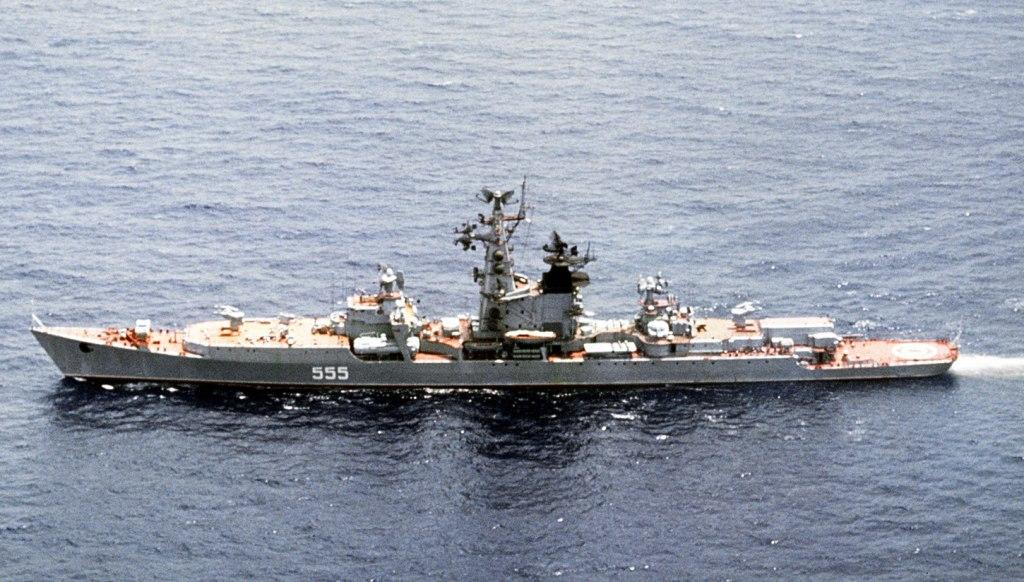
Built at A.A. Zhdanov yard (serial no. 791), she was laid down on 26.7.64, launched on 17.10.65 and on completed 8.10.67. Her sea trials started on 15.2.67.
On 7.11.67 took part in the naval parade off the Neva estuary, 50th anniversary of the October Revolution. In Nov-Dec. 67 she cruised in the Baltic, from Baltiysk to Severomorsk. From 18.1.68 she was attached to the 120th Missile Ship Brigade.
In the Summer 1968 she took part exercises “Sever-68” and “Arktika-68”. In October, she made her first launch of the P-35 missile. The next year took part in the “Kolskiy Bereg” exercise
From August to October, she took part in the endurance exercise “Zarya-2”, from Severomorsk to Crete and back.
Until July 1970 she was in operations in the Mediterranean, in support of Egypt. In April she took part in the “Okean-70” exercise in the Northeastern Atlantic, until July 1970 she was back in the Mediterranean again and in August 1970 return north, in the Barents and White Seas, launching her P-35 missile for tests.
From November 1971 to June 1974 she was undergoing her major overhaul, repairs and modernization at the A.A. Zhdanov Yard in Leningrad.
The remainder of 1975 and 1975 were spent in post-refit trials and training of the crew. In December 1975 she was back in operations in the Mediterranean and Central Atlantic with “Admiral Isakov”. In August 1975 she visited Annaba in Algeria and lost her Hormove helicopter in a crash on 11.9.75. Until November 1977 operations she operated in the Northern Atlantic and Mediterranean, alternating between the summer and winter. On 18.10.77 she visited Dubrovnik.
By late 1977 she was reclassified as a Missile Cruiser (RKR) and in September 1978 she shadowed and tracked NATO exercise “Northern Wedding-78” together with Admiral Makarov and Smyshlenyy. From 31 march to 8 april 1984 she took part in the “Atlantika-84” exercise.
She underwent another long overhaul and modernization in drydock from 22.4.85 to 1992 at KMOLZ, Kronshtadt, by the 95th independent battalion. This saw the installation of four AK-630M 30mm CIWS guns and updated electronics and IFF. In 1986 she was officially transferred to the Baltic Fleet and by May 1992 she was attached to the 12th Missile Ship Division. Following a boiler accident, her powerplant was deactivated in the summer 95 and she remained in harbour, decommissioned in 24.9.94, and scrapped.
Vitse-Admiral Drozd
Also from, A.A. Zhdanov (serial no. 793) laid down on 26.10.65, launched 18.11.66 and completed 27.12.68 in May 69 after sea trials and training, she was assigned to the 120th Missile Ship Brigade.
Until 16 September 1969 she operated in the Northern Atlantic and in August took part in the “Kolskiy Bereg” exercise with Gremyashchiy and Smyshlennyy. In March-April 1970 she took part in the “Okean-70” exercise and until July 1970 operated in the Norwegian Sea, before a sweep in the Central Atlantic and Caribbean Sea. She visited Cienfuegos in Cuba (possibly Havana too) as the traditional reward for the crew after good service.
In ealry 1971 Vitse-Admiral Drozd was in operations in the Northern Atlantic, Gulf of Mexico, Caribbean and Mediterranean seas, making another Cuban stop but from 13 April 1971 she started to track a foreign submarine, northeast of Ireland with the destroyer Skromnyy. She also tracked the NATO task force off the Faroe Islands. later she took part in the exercise Orbita and by December was back to the Central Atlantic, until 1972.
In January, she veered south to visit Conakry in Guinea, passed the equator for the first time and took part in March in a large rescue operation for the missing “K-19” in the Bay of Biscay. In May she was visited by Soviet Navy commander Gorshkov. In Sept-October she operated in the Faroe Island and Iceland submarine barrier. From 1973 to February 1975 she underwent her first long overhaul, repairs and modernization in her former builder, A.A. Zhdanov Yard in Leningrad. In March 1975 she departed to Severomorsk to operate with Admiral Isachenkov and the destroyer Smyshlennyy. Until the summer 1976 she took part in several operations in the Central Atlantic and Mediterranean, always escorted with Smyshlennyy. In the black sea she took part in the “Krym-76” exercise and visited Annaba in Algeria twice in between. In October she shadowed and observed the NATO exercise “Strong Express”.
By late 1977 she was reclassified as a Missile Cruiser but collided in June 1980 with the submarine K-508, slightly damaged on her keel, so she was repaired until 1984 repairs and modernized another time at KMOLZ in Kronshtadt, with the installation of four AK-630M 30mm CIWS. She was back in Severomorsk and in 1985 was in operations in the Mediterranean with Kiev, Sovremennyy and the destroyer Otlichnyy, Marshal Timoshenko and the Stroynyy. In May 1985 she visited Dubrovnik and until June 1986 was back in operations in the Mediterranean with the destroyers Otlichnyy and Smyshlennyy, and the cruiser Ognevoy. In April 1986 she visited Tripoli and Tobruk. Back to homeport she was immobilized in 1988 until decommission in July 1990, and sold for BU in 1992 to an Indian company but sank en route, in tow to India.
Vladivostok
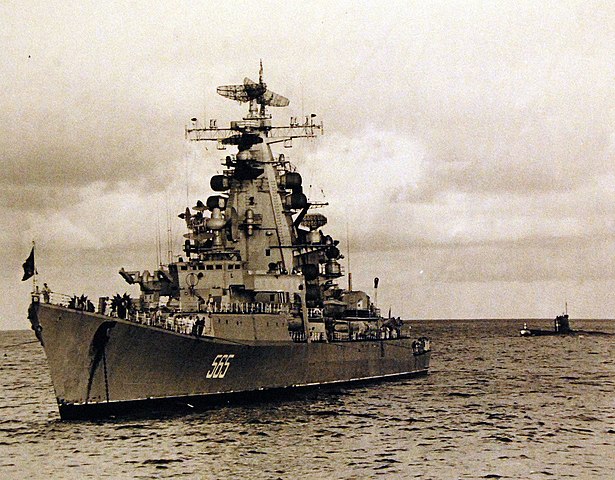
Vladivostok in hawaiian waters, with the Foxtrot class submarine
Like her sister ship she was built in Zhdanov NyD (Leningrad) under the hull serial no. 792. She was laid down 24.12.64, launched 1.8.67 and completed 11.9.69. In August and until 1969 to February 1970 she made her training cruiser in the Baltic. She transited to Vladivostok via the Black Sea and Suez canal, escorted by the Strogiy ande landing ship BDK-66, making joined operations in the Indian Ocean on her way, and visited Lagos in Nigeria, Berbera, Mogadishu and Chisimayu, Aden, , being refuelled by the tanker “Egorlyk”. From February 1970 she was attached to the 175th Missile Ship Brigade.
In October 1970 she made a missile firing exercise with the cruiser Varyag, oberved by the Strogiy. On 26 May 1970 she was visited by the Bulgarian General Secretary Zhivkov and at the end of this month, visited by a Polish delegation. In early August, she made other missile launches with the submarine K-23 notably to test the datalink. She also took part in an exercise with Admiral Fokin and the destroyer Strogiy, Odarennyy, Upornyy, Burlivyy and Bezboyaznennyy acting as the admiral and command ship, squadron leader. The mineweepers SKR-4, SKR-74, Sakhalinskiy Komsomolets, MT-59, MT-750 accompanied her until October 1971 for operations in the Central and Northwestern Pacific.
She was the center of another task force, with the destroyers Upornyy and Bezboyaznennyy, the submarines K-108, B-8 and B-135 and the landing ship Ivan Vakhrameev and tanker Zhitomir. This was a high mission profile, potentially hazardous as together they investigated USN training areas and tested US defences along the US west coast. Between December that year and March 1972 she was sent to the Indian Ocean as an observer during the Indian-Pakistan conflict, with the cruisers Dmitriy Pozharskiy and Varyag and the destroyers Strogiy and Veskiy. Their main task was to dissuade any intervention by the US and Royal Navies.
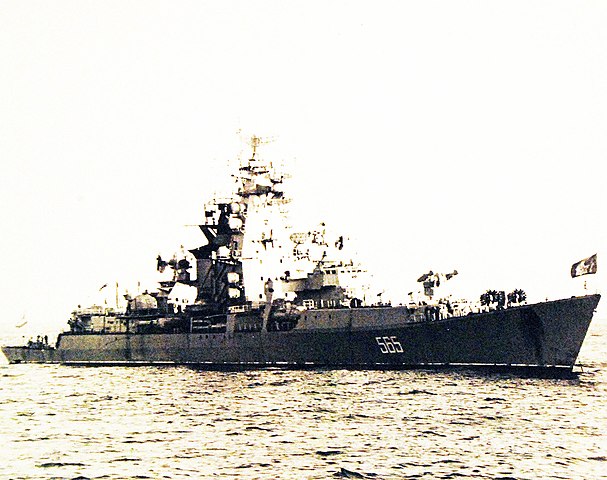
Vladivostok in Hawaiian waters, 1971
From there, she was assigned to the 201st Anti-Submarine Warfare Brigade, in Zolotaya Rog. in April she was anchored and open to the public in Vladivostok, until june, sailing with the minister of defence Grechko onboard, the Soviet Navy commander Gorshkov, and other high officials. Vitse-Admiral Drozd sailed from Vladivostok to Abraya Bay and back. In June 1973, while returning from a missile training mission, she collided with the science research ship Akademik Berg, sinking with 27 dead and leading to an investigation. She took part in the rescuing as well as the cruiser Vladivostok. By late 1977, she was reclassified as a Missile Cruiser (RKR) and until November 1977, her missile training has he moving in the Sea of Okhotsk.
By Aril 1978 she took part in an exercise with her escort the cruiser Marshal Voroshilov, Admiral Oktyabrskiy and the destroyers Sposobnyy and Razyashschiy. This was a high-profile parade and exercise observed by General Secretary Brezhnev and the Minister of Defence Ustinov, both from the bridge of the cruiser Admiral Senyavin. Until August 1979, she was operations in the Indian and visited Port Louis (Mauritius) with the minesweeper SKR-133 and the tanker Akhtuba. The squadron also stopped at Victoria (Seychelles), Maputo (Mozambique), Cam Ranh Bay (Vietnam), Dakhlak (Eritrea), and Aden in South Yemen twice. In Aprilto December 1980 she was back for exercises in the Indian Ocean, stopping in Mauritius, and later visited Beira (Mozambique), Cochin in India, and operated with the destroyer Odarennyy and tanker Pechenga from there.
In April 1984 she tracked the aicraft carrier USS Kittyhawk, directing the submarine K-314 to it for a mock attack. By 1987n she was seen in operations in the South China Sea. From September 1988 up to 23 April 1990 she was in drydock for overhaul and modernization at Dalzavod (Vladivostok). But the latter was only 90% completed when stopped due to the lack of funds following the collapse of the Soviet Union. She was by then attached to the 173rd Missile Ship Brigade. The overaul was never completed and she was decommissioned on 19 April 1990.
Sevastopol
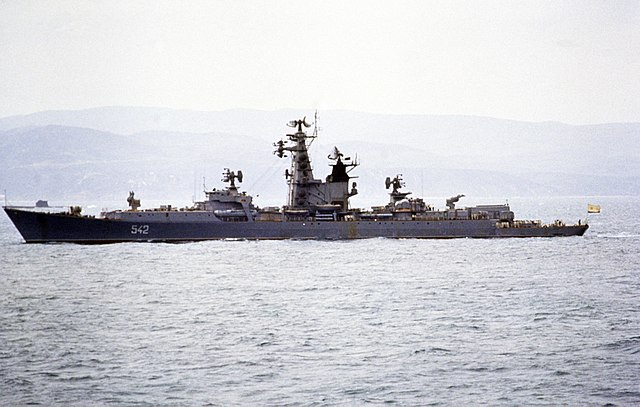
An unidentified Kresta I cruiser off Naples
The cruiser Sevastopol was from the same Zhdanov yard (hull serial no. 794), laid down in June 1966, launched in April 1967 and completed in September 1969. She was accepted into the Northern Fleet on the 21 October 1969, assigned to the 120th Missile Ship Brigade. In March-April 1970 she took part in the “Okean-70” exercise. From July to December she operated in the Atlantic and Mediterranean, escorted by the destroyer Smyshlennyy, two submarines and a tanker. The squadron successful tracked an unknwon SSBN of the George Washington class in the Mediterranean. In October-November, Sevastopol visited Havana in Cuba, as a reward to the crew.
In October 1972 and until April 1973 she was operating in the Atlantic, taking part in two anti-submarine exercises (“Duet” and “Ladoga”), Northeastern Atlantic, Norwegian Sea with Admiral Nakhimov and the destroyer Byvalyy. Until February 1973 she took part in a large ASW operation, temporarily based at Cienfuegos in Cuba. In April she visited Algiers and made later missile launches with the submarine K-128, using her helicopter and testing datalink between missiles. In May, she made a submarine hunt in the Northern Atlantic with Admiral Isakov and Admiral Makarov.
She was overhauled in drydock and modernized from December 1975 to March 1980 at SRZ-35 in Rosta. By late 1977 she was reclassified as a Missile Cruiser. From 19 October 1980 she was transferred to the Pacific Fleet, with the 175th Missile Ship Brigade. She sailed in July 1981 from Murmansk to Vladivostok along the northern arctic route. She stopped at Provideniya Bay and Petropavlovsk in the Kamchatka peninsula. In 1981 she mostly operated in the Indian Ocean, visiting Victoria in the Seychelles and Bombay. Until June 1983 she was repaired at Dalzavod in Vladivostok.
In October she made a sortie to search for the remnants of the downed Korean Airlines Boeing 747 together with Petropavlovsk, amidst international uproar and tensions. In July 1984 she was attached to the 173rd Missile Ship Brigade (Kamchatka Flotilla), after another overhaul and maintenance in January 86 at Dalzavod in Vladivostok. Until 1989 she experiences numerous preobles shortening her career, being under repairs three times at the SRZ-49 yard in Vilyuchinsk. In 1988 heavy ice damaged her hull eneough that she was decommissioned on 15 December 1989 decomissioned. A fire broke out in mid-1990 while she was mothballed. She was sold to an Indian company for scrapping and towed there in 1991.
Read more
Gardiner, Robert, ed. (1995). Conway’s All the World’s Fighting Ships 1947–1995
https://en.wikipedia.org/wiki/Kresta_I-class_cruiser
https://www.navypedia.org/ships/russia/ru_cr_admiral_zozulia.htm
https://www.globalsecurity.org/military/world/russia/ss-n-3-specs.htm
http://www.ausairpower.net/TE-Sov-ASuW.html
https://fas.org/nuke/guide/russia/theater/ss-n-3.htm
https://fas.org/nuke/guide/russia/airdef/s-125.htm
http://ship.bsu.by/ship/100600
http://www.ww2.dk/new/navy/kresta-1.htm
https://www.navypedia.org/ships/russia/ru_cr_admiral_zozulia.htm
https://web.archive.org/web/20050117235507/http://missilethreat.com/systems/s-125.html

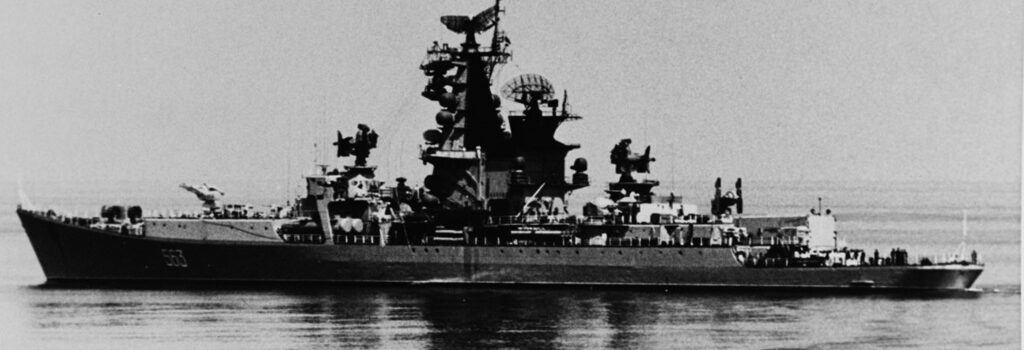

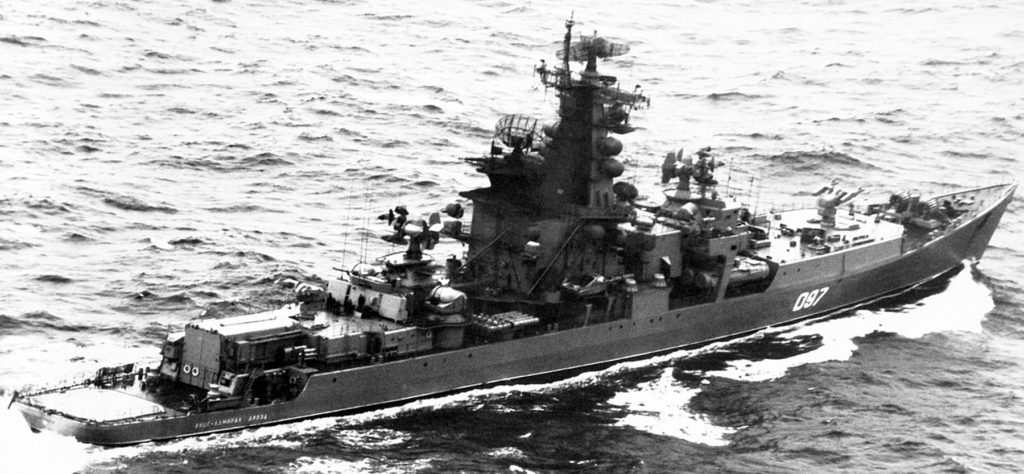
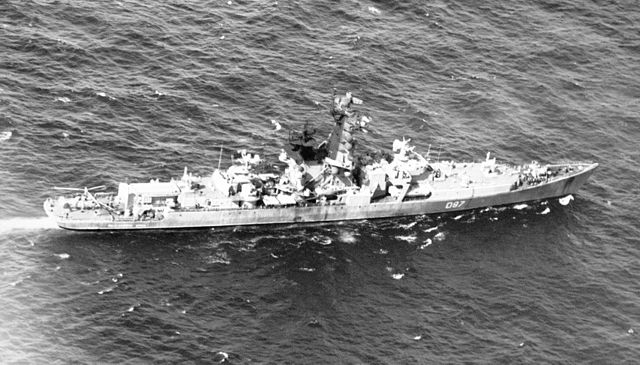
 Latest Facebook Entry -
Latest Facebook Entry -  X(Tweeter) Naval Encyclopedia's deck archive
X(Tweeter) Naval Encyclopedia's deck archive Instagram (@navalencyc)
Instagram (@navalencyc)





 French Navy
French Navy Royal Navy
Royal Navy Russian Navy
Russian Navy Armada Espanola
Armada Espanola Austrian Navy
Austrian Navy K.u.K. Kriegsmarine
K.u.K. Kriegsmarine Dansk Marine
Dansk Marine Nautiko Hellenon
Nautiko Hellenon Koninklije Marine 1870
Koninklije Marine 1870 Marinha do Brasil
Marinha do Brasil Osmanlı Donanması
Osmanlı Donanması Marina Do Peru
Marina Do Peru Marinha do Portugal
Marinha do Portugal Regia Marina 1870
Regia Marina 1870 Nihhon Kaigun 1870
Nihhon Kaigun 1870 Preußische Marine 1870
Preußische Marine 1870 Russkiy Flot 1870
Russkiy Flot 1870 Svenska marinen
Svenska marinen Søværnet
Søværnet Union Navy
Union Navy Confederate Navy
Confederate Navy Armada de Argentina
Armada de Argentina Imperial Chinese Navy
Imperial Chinese Navy Marinha do Portugal
Marinha do Portugal Mexico
Mexico Kaiserliche Marine
Kaiserliche Marine 1898 US Navy
1898 US Navy Sovietskiy Flot
Sovietskiy Flot Royal Canadian Navy
Royal Canadian Navy Royal Australian Navy
Royal Australian Navy RNZN Fleet
RNZN Fleet Chinese Navy 1937
Chinese Navy 1937 Kriegsmarine
Kriegsmarine Chilean Navy
Chilean Navy Danish Navy
Danish Navy Finnish Navy
Finnish Navy Hellenic Navy
Hellenic Navy Polish Navy
Polish Navy Romanian Navy
Romanian Navy Turkish Navy
Turkish Navy Royal Yugoslav Navy
Royal Yugoslav Navy Royal Thai Navy
Royal Thai Navy Minor Navies
Minor Navies Albania
Albania Austria
Austria Belgium
Belgium Columbia
Columbia Costa Rica
Costa Rica Cuba
Cuba Czechoslovakia
Czechoslovakia Dominican Republic
Dominican Republic Haiti
Haiti Hungary
Hungary Honduras
Honduras Estonia
Estonia Iceland
Iceland Eire
Eire Equador
Equador Iran
Iran Iraq
Iraq Latvia
Latvia Liberia
Liberia Lithuania
Lithuania Mandchukuo
Mandchukuo Morocco
Morocco Nicaragua
Nicaragua Persia
Persia San Salvador
San Salvador Sarawak
Sarawak Uruguay
Uruguay Venezuela
Venezuela Zanzibar
Zanzibar Warsaw Pact Navies
Warsaw Pact Navies Bulgaria
Bulgaria Hungary
Hungary

 Bundesmarine
Bundesmarine Dutch Navy
Dutch Navy Hellenic Navy
Hellenic Navy Marina Militare
Marina Militare Yugoslav Navy
Yugoslav Navy Chinese Navy
Chinese Navy Indian Navy
Indian Navy Indonesian Navy
Indonesian Navy JMSDF
JMSDF North Korean Navy
North Korean Navy Pakistani Navy
Pakistani Navy Philippines Navy
Philippines Navy ROKN
ROKN Rep. of Singapore Navy
Rep. of Singapore Navy Taiwanese Navy
Taiwanese Navy IDF Navy
IDF Navy Saudi Navy
Saudi Navy Royal New Zealand Navy
Royal New Zealand Navy Egyptian Navy
Egyptian Navy South African Navy
South African Navy






























 Ukrainian Navy
Ukrainian Navy dbodesign
dbodesign